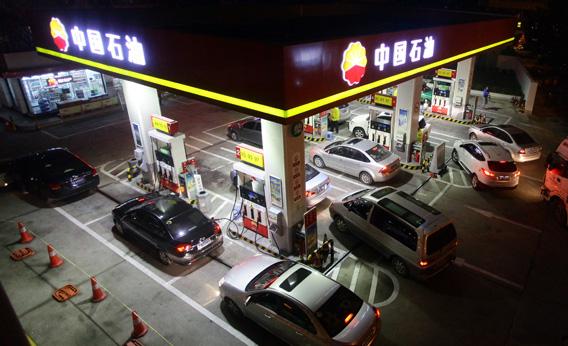Starting next year, for the first time on record the wealthy nations of Europe, North America, and Japan will account for less than one-half the world’s oil usage, projects the latest Oil Market Report from the International Energy Agency.
The New Gas Guzzlers
China, India, Brazil and other developing countries will soon consume most of the world’s oil. That’s alarming news for the U.S.

Photograph by ChinaFotoPress/Getty Images.
That’s partially a reflection of the growing efficiency of wealthy nations, and partially a reflection of poor countries’ growing prosperity. But it’s also a specific challenge for the United States of America, which, unlike our smaller rich peers, has grown accustomed to thinking of itself as master of its own destiny. A world in which a majority of oil consumption is happening in China, India, and Latin America is a world in which America’s energy fate is driven by forces beyond our control. And we’re pretty far behind in preparing for it.
Demand for oil in rich countries has been falling for six years. In North America and Europe, year-on-year oil consumption declined every year but one since 2007. (The exception year of 2010 was a weak, one-off bounce-back from a recession, not a real interruption of the trend.) The causes of the decline are varied, but they start with steady improvement in vehicle fuel economy. Throw in the fact that U.S. vehicle-miles traveled (VMT) have been slowly declining as a result of demographic trends (more old people, fewer parents with kids at home) and the increased fashionability of urban living, and the transportation sector is primed for declining oil use. Meanwhile, cheap natural gas has cut into nontransportation oil usage.
By contrast, demand for oil has been booming outside of the rich countries of the Organization for Economic Cooperation and Development. The IEA forecasts that non-OECD gasoline demand will rise 4.2 percent in the second half of 2012.
In countries that are poor but rapidly growing, the raw increase in the number of vehicles on the road swamps any technical improvements in their efficiency. If a prosperous Brazilian family upgrades to a shiny new Prius, whatever they used to be driving will find a loving home with a previously carless family, just lately rich enough to afford a used clunker. Millions of Chinese people are converting each month from bicycles to scooters and from scooters to small cars, while the country’s top 2 or 3 percent develop for the first time a taste for western luxury vehicles. It’s quite possible that average gas mileage in developing world automobile fleets is in fact rising, but the fleets are growing so fast so that the total demand for oil is voracious.
And as countries get richer, they have more business travelers and tourists. China used 357,000 barrels of jet fuel per day in 2010 and is up to 403,000 per day in 2012.
In the real world, nothing magical will occur when the lines between rich-world and developing-world oil consumption cross in the near future. But the shift is emblematic of a changed reality that hasn’t yet been fully processed by Americans. We’re used to living in a world where rich countries were the whole ballgame and the American economy was so much bigger than Germany’s or Japan’s that we could afford to treat the global economy and the American one as largely coextensive. Those days are gone. In the near future, trends in global commodity prices—most of all the highly variable price of gasoline—are more likely to be driven by policy changes in Asia than in the United States, making America’s perennial game of political whining about the price of gasoline even more ridiculous than usual.
Other rich countries, generally being fairly small, have been in this boat for decades. And generally they’ve responded in the smart way, not by adopting public policies designed to guarantee the availability of cheap gasoline but by trying to insulate their economies from the impact of price swings. They do that first and foremost by imposing substantially higher taxes on gasoline. In a small way, that reduces the real volatility of the price paid by the consumer. But the bigger impact is simply that it pushes households to organize lives to be less dependent on lavish gas consumption. For some this is a matter of walking or taking mass transit to work. But the biggest difference is simply lighter, less fuel-intensive cars. Such a move here would have the added benefit of plugging the hole in our current transportation infrastructure trust fund that’s currently being filled with one-off gimmicks.
Unfortunately, any such move in the United States is politically inconceivable at the moment. But the developing world’s thirst for oil is only going to grow. Poor countries can enrich themselves at the pace it takes to transfer or imitate production technologies already in use in rich places. But rich countries—and global oil supply—can only grow at the much slower pace at which genuine innovation takes place. And this kind of catch-up consumption growth is really only getting started. The IEA anticipates that the fastest demand growth over the next year will come from Africa, where economic growth has been quietly gaining momentum. There’s nothing America can possibly do, policy-wise, to obtain overall growth rates as rapid as those enjoyed by countries reversing decades of terrible public policy. That’s going to mean less affordable commodities for Americans, even as our polarized political system prevents us from responding to those higher prices with more sensible policies.